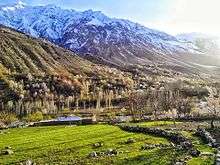Garam Chashma

Garam Chashma (literally: Hot Spring) is one of the many branch valleys of Chitral District, situated in the extreme north-west of Pakistan.[1] It is one of the highest human settlements in the Hindu Kush ranges with an altitude of almost 2550 meters (8389 feet). The place is known for Hot spring, which is one of the tourists attraction sites. It is also famous for its trout fish. The water flowing down through the length of the valley is famous for fishing sport. The Lotkoh River (Garam Chashma River) running down from the lofty peaks of the Hindu Kush is a heaven for the brown type of trout fish. Other features of the area include snow-covered peaks, pleasant weather, natural springs, and more recently has remained in the limelights for being a potential site of hydel-power generation.[2] Besides tourists, people suffering from skin diseases also visit the hot spring for treatment.[3] It is located in the North-West of Chitral at a distance of about forty-five kilometres by road.[1] It shares international borders with Afghanistan being situated in the extreme North-West of Pakistan. Dorāh (Do Rāh) Pass (14,940 feet [4,554 metres)[4] connects this part of Pakistan with Badakhshan, the adjacent province of Afghanistan.[5]
The Hot Spring
The spring water emerges from underground sulphur deposits making its temperature rise above boiling point. For the same reason, the spring is also known as Sulphur Spring.[3] The spring is the warmest in the westward extension of the Himalayan Geothermal Belt. It emerges from leucogranites of the Hindu Kush Range that date from 20–18 Ma. Reservoir temperatures may be as high as 260 °C (500 °F). It is not clear whether the circulation of deep groundwater in this region is driven by topography or by tectonic lateral stress.[6]
Demography
The population of Garam Chashma is approximately 50 thousand people. Since the last census in Pakistan was conducted in 1998, there isn't any exact source of information in this regard. The male to female ratio is almost 50-50. almost 60 percent of this population constitutes of the young people.
Languages
Khowar[7] is the main language spoken and understood by majority of the population. Yidgha language (Iranic Pamirian dialect, relate Munji) is the second largest spoken dialect in the area, unfortunately, this beautiful language is on the verge of extinction.[8] An extremely small number of people, in Gobor valley, also speak Sheikhan-War, a dialect spoken in Nuristan province of Afghanistan. In addition, many people understand and some can even speak Dari (Farsi). This is due to the influence of Nasir-Khisraw,[9] the eleventh-century, poet, and philosopher. One of his disciples had come to this part of the region and got settled here permanently. He preached the Ismaili thought, hence marking the dawn of Ismailism[10] in this part of the world. More recently, the neighbouring country, Afghanistan, was involved in the war with the USSR, as a result, a huge influx of refugees fled to this area. Since Garam Chashma was easily accessible from Badakhshan, many Afghans chose to stay back and some of the refugees are still living in here. This interation with Dari speakers frefreshedthe memories associated with Dari (Farsi).
Educational Institutions
- Aga Khan Schools (A network of schools from ECD-High School, spread across the area)
- Government Higher Secondary School Garam Chashma
- Government Higher Secondary School for Women, Izh, Garam Chashma
- Government Primary and Middle School (a network of schools spead across the area)
- Pamir Public School and College, Garam Chashma[11]
- Al-Nasir Community Based School, Garam Chashma
- Chamber of Commerce College, Garam Chashma
- Injigan Ideal Public school
References
- 1 2 Tahir Jahangir (24 February 2005). A Travel Companion to the Northern Areas of Pakistan. USA: Oxford University Press. pp. 52, 57, 63. ISBN 978-0195799699.
- ↑ Mirza, Sana (2 May 2016). "www.jaag.tv". www.zemtv.com. www.zemtv.com. Retrieved 13 May 2016.
- 1 2 Zahiruddin (7 March 2011). "Chitral`s Garam Chashma popular for its healing touch". Dawn. Retrieved 2 November 2012.
- ↑ "Hindu Kush | mountains, Asia". Encyclopedia Britannica. Retrieved 2016-06-05.
- ↑ electricpulp.com. "CHITRAL – Encyclopaedia Iranica". www.iranicaonline.org. Retrieved 2016-05-13.
- ↑ Hochstein, M.P.; Regenauer-Lieb, K. (July 1998). "Heat generation associated with collision of two plates: the Himalayan geothermal belt". Journal of Volcanology and Geothermal Research. 83 (1–2): 75. doi:10.1016/s0377-0273(98)00018-3. Retrieved 2015-02-12.
- ↑ "Khowar language, alphabet and pronunciation". www.omniglot.com. Retrieved 2016-05-22.
- ↑ Janjua, Fauzia (2011-05-01). "Causes of Decline of Yadgha Language". Canadian Social Science. 7 (2): 249–255. doi:10.3968/j.css.1923669720110702.034. ISSN 1712-8056.
- ↑ "Khusraw, Nasir | Internet Encyclopedia of Philosophy". www.iep.utm.edu. Retrieved 2016-05-22.
- ↑ "Ismaili Philosophy | Internet Encyclopedia of Philosophy". www.iep.utm.edu. Retrieved 2016-05-22.
- ↑ "Pamir Public School & College". www.pamir.edu.pk. Retrieved 2016-05-22.
- “Concise Biological Glance on Garamchishma Hot Spring”. Aftab Khan, Pakistan Medical Research Council, Khyber Medical college Peshawar
Coordinates: 35°59′50″N 71°33′50″E / 35.99722°N 71.56389°E
